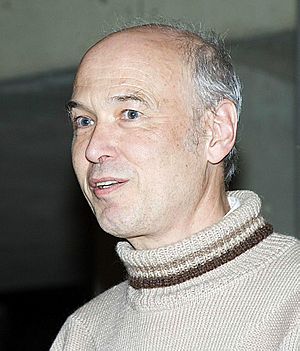Pierre Deligne facts for kids
Quick facts for kids
Pierre Deligne
|
|
|---|---|

Deligne in March 2005
|
|
| Born | 3 October 1944 Etterbeek, Belgium
|
| Nationality | Belgian |
| Education | Université libre de Bruxelles (BS) Paris-Sud University (MS, PhD) |
| Known for | Proof of the Weil conjectures Perverse sheaves Concepts named after Deligne |
| Awards | Abel Prize (2013) Wolf Prize (2008) Balzan Prize (2004) Crafoord Prize (1988) Fields Medal (1978) |
| Scientific career | |
| Fields | Mathematics |
| Institutions | Institute for Advanced Study Institut des Hautes Études Scientifiques |
| Doctoral advisor | Alexander Grothendieck |
| Doctoral students | Lê Dũng Tráng Miles Reid Michael Rapoport |
Pierre Deligne (born October 3, 1944) is a famous Belgian mathematician. He is best known for solving the difficult Weil conjectures in 1973. These conjectures were big puzzles in mathematics.
Deligne has won many important awards for his work. These include the Abel Prize in 2013 and the Fields Medal in 1978. The Fields Medal is like the Nobel Prize for mathematics.
Contents
Early Life and School
Pierre Deligne was born in Etterbeek, a town in Belgium. He went to school at Athénée Adolphe Max. Later, he studied at the Université libre de Bruxelles (ULB).
He wrote a paper there about something called the "Lefschetz theorem." He then earned his PhD in 1972. This was at the University of Paris-Sud in France. His main teacher was Alexander Grothendieck, another very famous mathematician.
A Career in Mathematics
Deligne started working at the Institut des Hautes Études Scientifiques (IHÉS) in France in 1965. He worked with Grothendieck on advanced math ideas. He also worked with Jean-Pierre Serre in 1968. Their work helped understand special math patterns called "modular forms."
Deligne also studied Hodge theory, which connects different areas of math. He worked with David Mumford on how to describe shapes in math. This work is now used in areas like string theory, which tries to explain how the universe works.
Solving the Weil Conjectures
Deligne's most famous achievement was proving the Weil conjectures. These were three big problems in a field called algebraic geometry. Many mathematicians had tried to solve them for years.
His proof was a huge step forward in mathematics. It helped prove other important ideas, like the Ramanujan–Petersson conjecture. This showed how numbers and patterns are connected. Deligne's work in 1974 gave the first full proof of these conjectures.
He found a way to estimate special numbers called "eigenvalues." This was like finding a missing piece of a puzzle. It helped connect geometry with number theory.
From 1970 to 1984, Deligne was a permanent member at IHÉS. During this time, he did other important work. He worked with George Lusztig on understanding groups of numbers. He also worked with Michael Rapoport on "moduli spaces." He received the Fields Medal in 1978 for all his amazing contributions.
In 1984, Deligne moved to the Institute for Advanced Study in Princeton, USA. He continued his research there.
Other Important Work
Deligne also helped develop the theory of "perverse sheaves." This is a complex math idea that helps solve difficult problems. It was used in the recent proof of the fundamental lemma. This lemma is a key part of the Langlands program, which links different areas of mathematics.
He also worked with other mathematicians on topics like homotopy theory. This area studies shapes and spaces. His work helped answer important questions in complex geometry.
Awards and Honors
Pierre Deligne has received many top awards for his mathematical discoveries:
- Fields Medal (1978)
- Crafoord Prize (1988)
- Balzan Prize (2004)
- Wolf Prize (2008)
- Abel Prize (2013)
The Abel Prize recognized his "seminal contributions to algebraic geometry." It also noted how his work changed number theory and other fields. In 1978, he became a foreign member of the Academie des Sciences de Paris.
In 2006, the King of Belgium made him a viscount. This is a special honor. In 2009, he was also chosen as a member of the Royal Swedish Academy of Sciences. He is also a member of the Norwegian Academy of Science and Letters.
Concepts Named After Deligne
Many mathematical ideas are named after Pierre Deligne because of his important work:
- Deligne–Lusztig theory
- Deligne–Mumford moduli space of curves
- Deligne–Mumford stacks
- Fourier–Deligne transform
- Deligne cohomology
- Weil–Deligne group
Several math puzzles, called "conjectures," also carry his name:
- The Deligne's conjecture on Hochschild cohomology
- The Deligne conjecture on special values of L-functions
- The Deligne conjecture on monodromy (also known as the weight monodromy conjecture)
See also
 In Spanish: Pierre Deligne para niños
In Spanish: Pierre Deligne para niños
- Hodge–de Rham spectral sequence
- Moduli of algebraic curves
- Perverse sheaf
- Riemann–Hilbert correspondence

